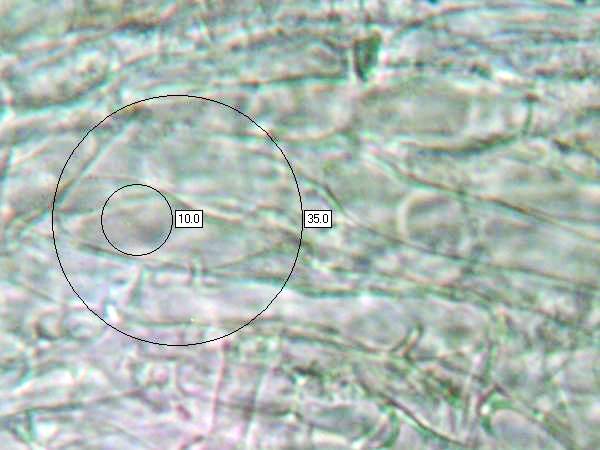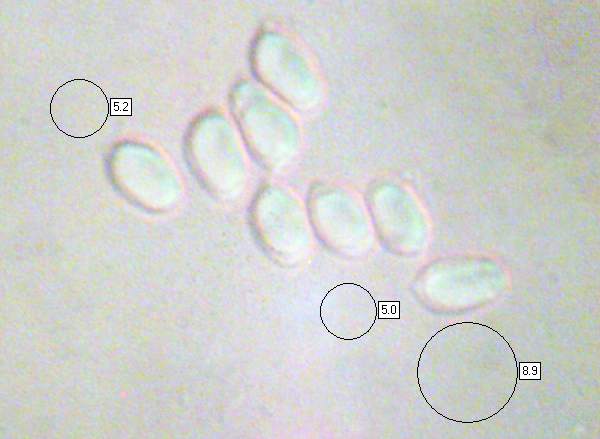Hygrocybe punicea (Fr.) P. Kumm. - Crimson Waxcap
Phylum: Basidiomycota - Class: Agaricomycetes - Order: Agaricales - Family: Hygrophoraceae
Distribution - Taxonomic History - Etymology - Identification - Culinary Notes - Reference Sources
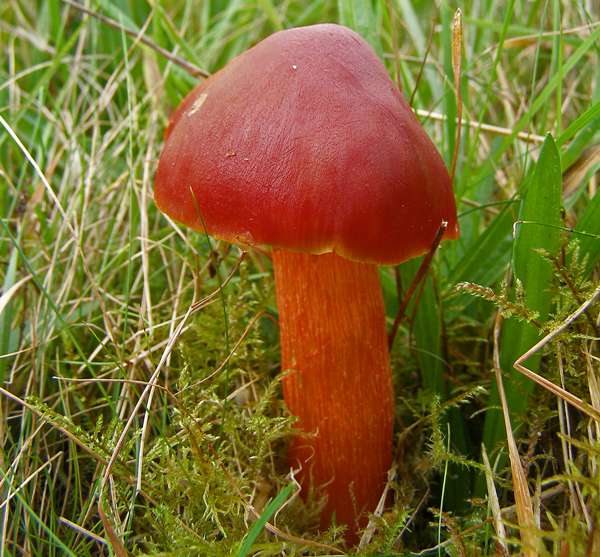
One of the largest of the waxcaps, Hygrocybe punicea is an infrequent find on cropped grassland and regularly mown churchyards. It occurs in late summer and autumn. This lovely mushroom often occurs in small clusters, and when young it is sometimes covered with a whitish bloom. Initially deep blood red, the caps develop paler patches as they age.
The Crimson Waxcap is often confused with the much-more-common Scarlet Waxcap Hygrocybe coccinea, which is generally a smaller and more gregarious mushroom with a brighter red cap that is sometimes yellowish towards the margin even when young and not fully expanded.
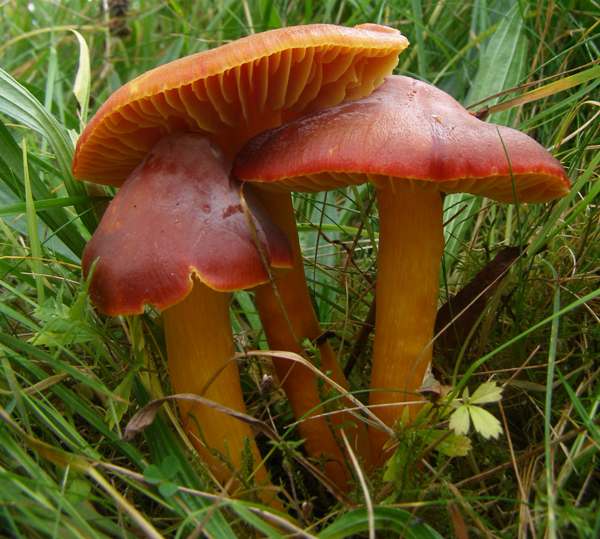
Distribution
Widespread in Britain and Ireland, particularly in upland areas on acidic soil, the Crimson Waxcap is also found across most of central and northern mainland Europe where grassland of high enough quality (low in nutrients and in particular not treated with artificial fertilisers) occurs. This waxcap is recorded also in parts of North America, where it is mainly a woodland species.
Taxonomic history
In his Systema mycologicum of 1821 the pioneering Swedish mycologist Elias Magnus Fries described the Crimson Waxcap, giving it the name Agaricus puniceus (at a time when most gilled mushrooms were included initially in the genus Agaricus). It was the German mycologist Paul Kummer who, in 1871, transferred this species to the Hygrocybe genus, thus creating its currently-accepted scientific name.
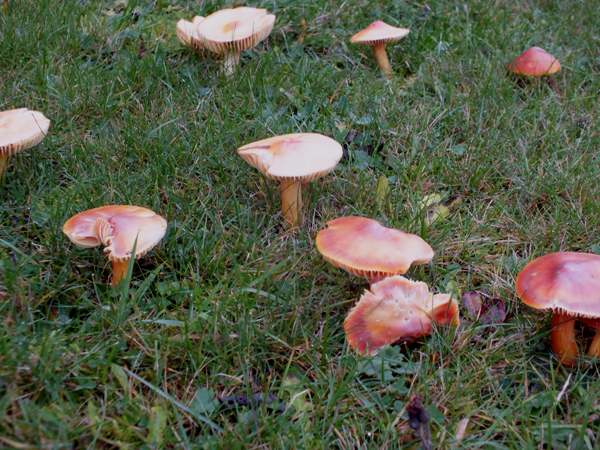
Synonyms of Hygrocybe punicea include Agaricus puniceus Fr., Hygrophorus puniceus (Fr.) Fr., and Hygrocybe acutopunicea R. Haller Aar. & F.H. Møller.
Etymology
The genus Hygrocybe is so named because fungi in this group are always very moist. Hygrocybe means 'watery head'. The specific epithet punicea comes from Latin and means crimson or purplish red.
Above: Although often either solitary or with just a few scattered fruitbodies, occasionally, as in this example, Hygrocybe punicea fruits gregariously. This picture shows just a few of a group of some 30 mushrooms on a lawn that had in the past been part of an old churchyard in south Ceredigion, Wales.
Wales is one of the very best places in Europe for seeing these and many other waxcaps.
Identification guide
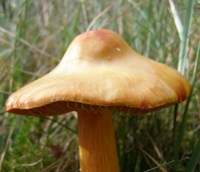 |
CapThe 3 to 10cm diameter domed or broadly umbonate caps with irregular downturned margins are dark blood red with usually a yellowish margin. The caps fade gradually, often in patches from the centre outwards, to become yellowish buff (as in the mature specimen shown on the left, above, and in the aged umbonate example seen here on the immediate left). Apart from in very wet weather or extreme drought, the caps are greasy to moderately slimy. |
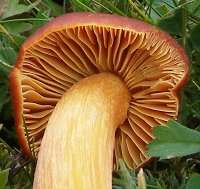 |
GillsInitially yellow, but reddening gradually as the fruitbody ages, the gills are adnexed or free; they are moderately distant. |
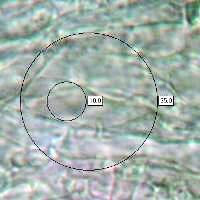 |
Gill tramaParallel (regular) or only slightly interwoven, elements mainly 5 to 12µm in width.
|
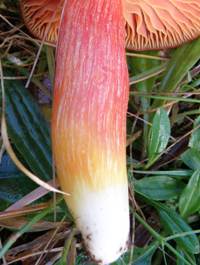 |
StemLevel, 5 to 15cm long and 1.3 to 2cm in diameter, with a somewhat rooting base; no stem ring; coarsely fibrillose; yellow flushed with red in its upper section, shading into orange and then white towards the base. In all but very wet weather the stems of the Crimson Waxcap are dry to the touch. |
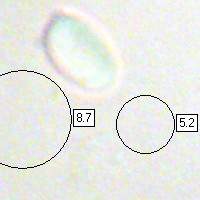 |
SporesEllipsoidal to cylindrical, smooth, 8-11 x 4.5-5.5µm; inamyloid.
Spore printWhite. |
Odour/taste |
Not distinctive. |
Habitat & Ecological role |
Sometimes solitary but more often in small groups on closely cropped or mown grassland where artificial fertilisers are not spread. Waxcaps have long been considered to be saprobic on the dead roots of grasses and other grassland plants, but it is now considered likely that there is some kind of mutual relationship between waxcaps and mosses. |
Season |
August to November in Britain and Ireland. |
Similar species |
Hygrocybe coccinea is smaller, usually a brighter red, and has a less fibrous reddish stem. Hygrocybe splendidissima, the Splendid Waxcap, is similar although typically slightly smaller; its cap does not turn blotchy and fade to buff, and its stem is usually flattened and twisted so that the longitudinal fibres form spiral patterns around the stem. (In the past it was considered to be merely a form of Hygrocybe punicea.) Hygrocybe conica has a more pointed cap and yellow stem flesh; it turns black with age or when cut. |
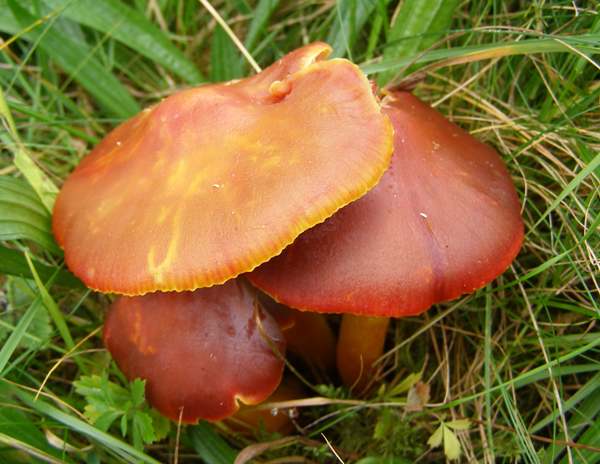
Culinary Notes
The Crimson Waxcap is reported to be edible, and being a large mushroom it does look quite tempting; however, there are reports from the USA of people suffering very unpleasant stomach upsets after eating this species. This is one of the most beautiful of all waxcaps, and without doubt the best feast you can get from the Crimson Waxcap is a feast for the eyes. Other than for research purposes, we would never want to pick these 'orchids of the fungi world'.
As the young Crimson Waxcaps on the right demonstrate, in dry weather these grassland mushrooms may begin fading long before the caps have fully expanded. Waxcaps are not the easiest of fungi to identify, and relying on cap colour is not wise; even whenthe experts have checked all of the identifying characters they do not always reach a definite conclusion.
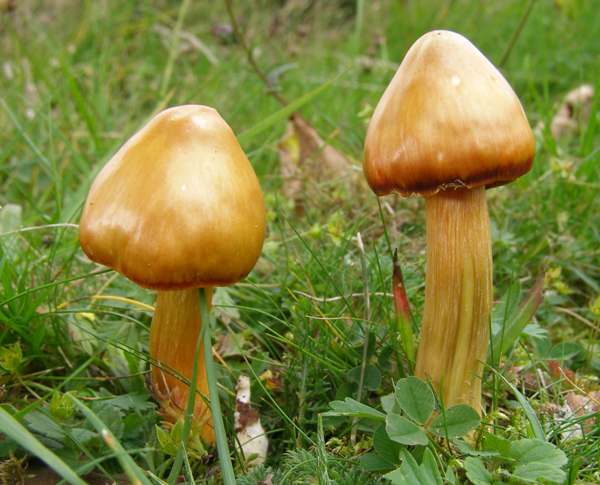
Reference Sources
Fascinated by Fungi, 2nd Edition, Pat O'Reilly 2016, reprinted by Coch-y-bonddu Books in 2022.
Fungi of Northern Europe, Volume 1 - The Genus Hygrocybe, David Boertmann, 2010.
Dictionary of the Fungi; Paul M. Kirk, Paul F. Cannon, David W. Minter and J. A. Stalpers; CABI, 2008
Taxonomic history and synonym information on these pages is drawn from many sources but in particular from the British Mycological Society's GB Checklist of Fungi.
Fascinated by Fungi. Back by popular demand, Pat O'Reilly's best-selling 450-page hardback book is available now. The latest second edition was republished with a sparkling new cover design in September 2022 by Coch-y-Bonddu Books. Full details and copies are available from the publisher's online bookshop...

